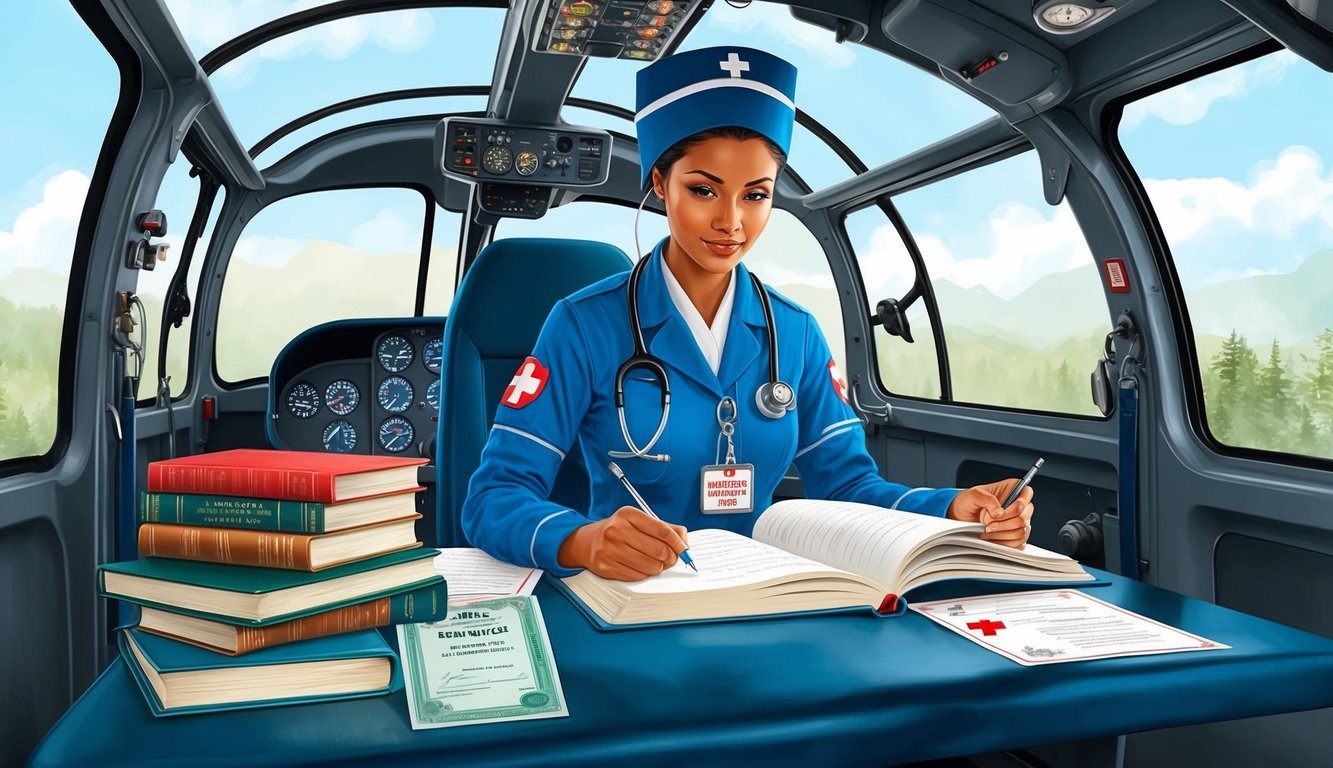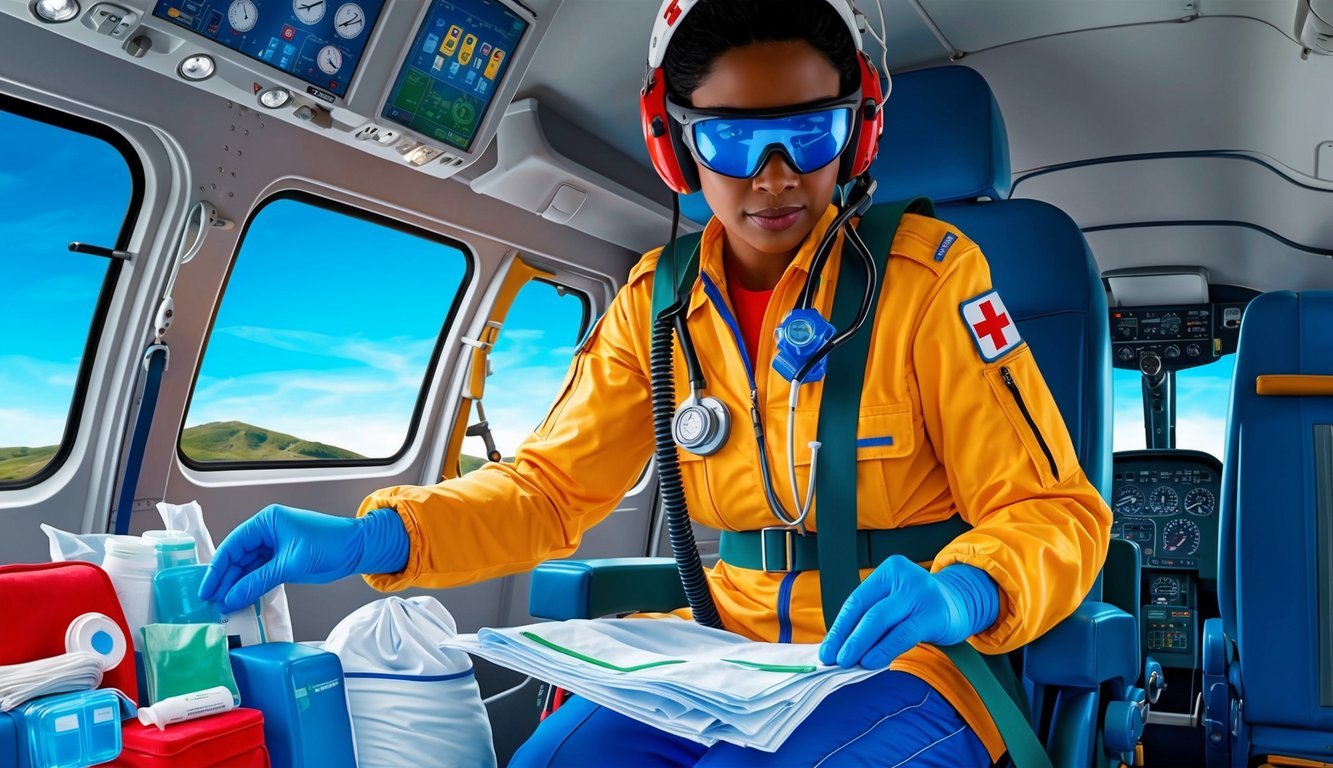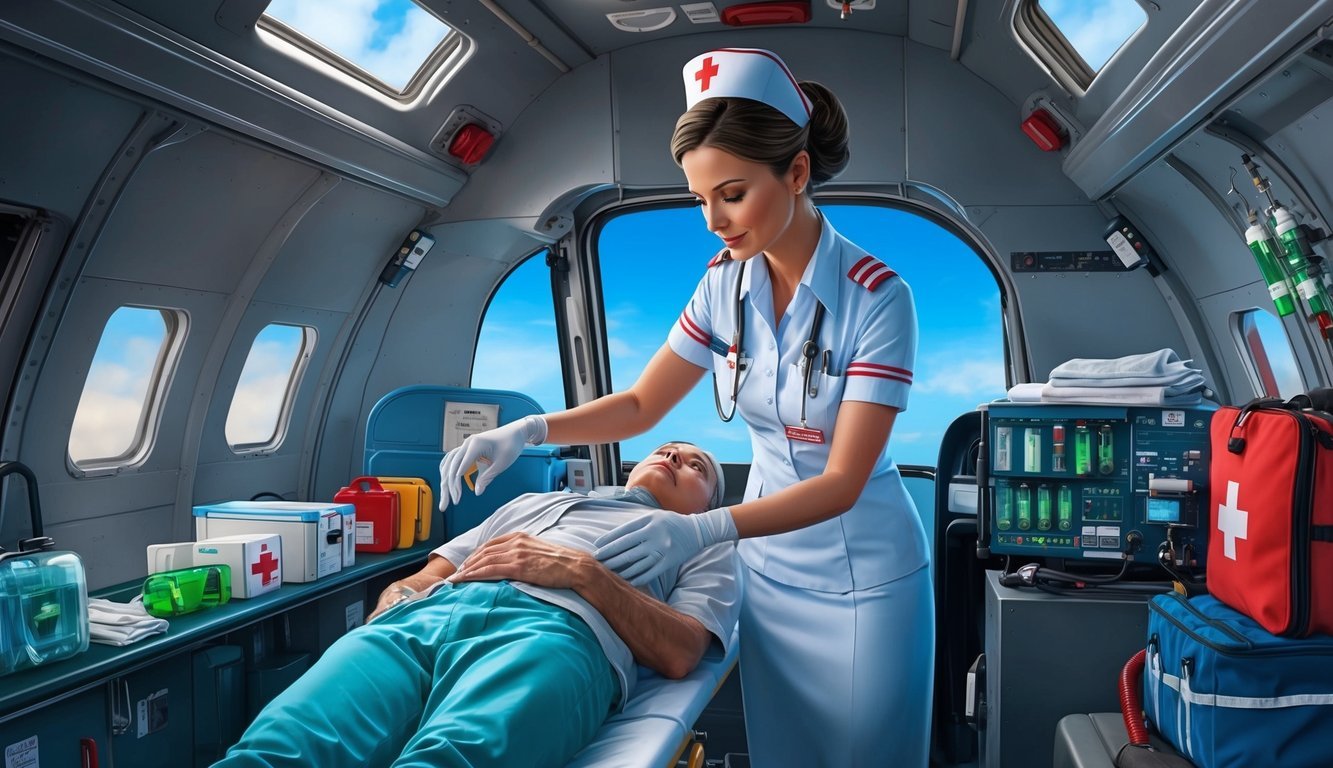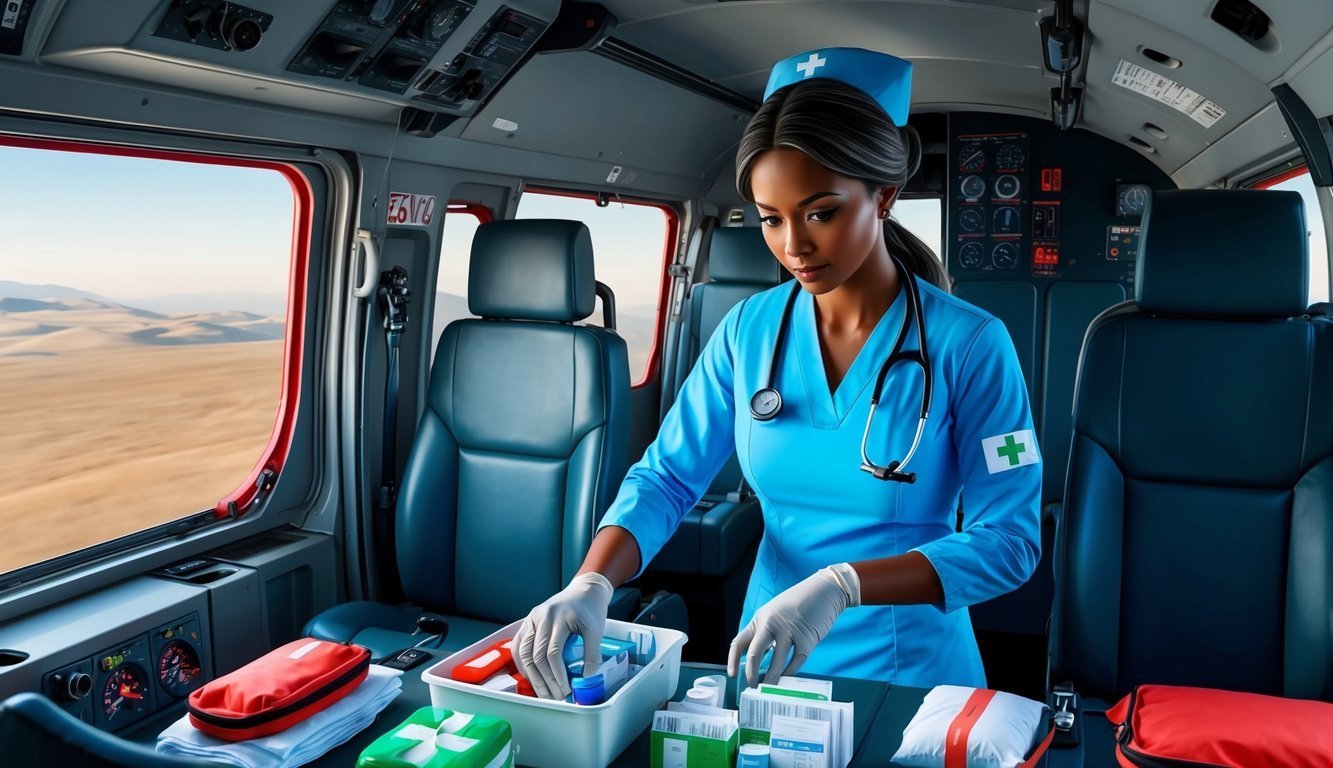Becoming a flight nurse is an exciting career choice for those interested in emergency medical care and aviation. Flight nurses provide critical support to patients during airborne medical transport.
They ensure patients receive prompt and effective care while in transit. This role requires a combination of advanced clinical skills and a unique set of training in medical transport.
Flight nurses play a vital role in emergency situations.
They work closely with other medical professionals to assess patient needs and provide appropriate treatment.
To pursue this career, you typically need a nursing degree and specific certifications that prepare you for the challenges of working in a dynamic environment.
Navigating the pathway to becoming a flight nurse involves understanding the education, certification, and skill requirements.
Being aware of what to expect in this field will help you make informed decisions about your future in healthcare.
Key Takeaways
- Flight nurses are essential for medical transport during emergencies.
- A nursing degree and specialized training are required for this role.
- Understanding the career path can help you enter this exciting field.
Flight Nurse Role and Responsibilities
As a flight nurse, you play a vital role in providing critical care during air transport.
Your responsibilities encompass emergency response, performing medical procedures in-flight, and maintaining strong communication with your team and patients.
Emergency Response and Care
In emergency situations, your first duty is to assess and stabilize the patient’s condition. You must quickly identify life-threatening issues and prioritize interventions. This often involves performing advanced resuscitation techniques, like CPR and using defibrillators.
Key skills include:
- Critical Thinking: Analyzing a patient’s status rapidly.
- Emergency Nursing: Applying your knowledge of critical care in unstable environments.
- Patient Care: Providing compassionate support to patients and their families.
You must be prepared for any situation, ensuring lifesaving measures are taken swiftly.
In-Flight Medical Procedures
During flights, you are responsible for executing various medical procedures.
This might include administering medications, starting intravenous (IV) lines, and monitoring vital signs closely.
Common procedures involve:
- Administering Medications: Ensuring correct dosages and methods.
- Monitoring Vital Signs: Keeping track of blood pressure, heart rate, and oxygen levels.
- Responding to Emergencies: Acting swiftly if a patient’s condition worsens.
Your ability to manage these procedures efficiently can be life-saving.
Training is crucial, as the high-pressure environment demands quick, accurate decision-making.
Communication and Teamwork
In your role, effective communication is essential.
You must relay information accurately between team members and provide updates on patient conditions.
Important aspects include:
- Clear Communication: Sharing critical data with pilots and medical staff.
- Teamwork: Collaborating with EMTs, paramedics, and other healthcare professionals to deliver comprehensive care.
- Patient Advocacy: Ensuring that the patient’s needs are addressed.
Strong teamwork enhances the overall effectiveness of medical care during transport, leading to better outcomes for patients.
Educational Path and Certifications

To become a flight nurse, you must complete specific educational requirements and obtain various certifications.
The journey begins with earning a nursing degree and passing the necessary licensing exams.
Additionally, specialized training and certifications are required to enhance your skills in emergency and critical care settings.
Nursing Degrees and Licenses
Your first step is to earn a Bachelor of Science in Nursing (BSN), as many employers require it.
However, you can also pursue an Associate Degree in Nursing (ADN), but a BSN often provides better job opportunities.
Once you have completed your degree, you must pass the NCLEX-RN exam to obtain your Registered Nurse (RN) licensure.
This exam tests your knowledge in various nursing domains.
After passing, you’ll be eligible to practice as a registered nurse.
Specialized Flight Nurse Training
Gaining experience in critical care or emergency nursing is crucial before transitioning to flight nursing.
Typically, you should have 2-5 years of bedside experience in emergency departments or intensive care units.
This experience equips you with the necessary skills to handle high-pressure situations, which are common in flight nursing.
In many cases, you may also pursue additional training such as Pre-Hospital Trauma Life Support (PHTLS) or Advanced Cardiac Life Support (ACLS).
These certifications enhance your ability to provide critical care in transit.
Certification Exams
To formalize your qualifications for flight nursing, you should consider obtaining the Certified Flight Registered Nurse (CFRN) credential.
This certification demonstrates your expertise and commitment to the specialty.
To earn this, you must meet specific clinical experience requirements and pass the CFRN exam offered by the Board of Certification for Emergency Nursing (BCEN).
Additionally, you might explore the Pediatric Advanced Life Support (PALS) and Basic Life Support (BLS) certifications.
These certifications can further prepare you for the challenges you will face as a flight nurse, ensuring you provide high-quality care in emergency situations.
For further guidance on nursing education and licensing, consider visiting NurseJournal or AAMCN.
Clinical Skills and Competencies

In flight nursing, having the right clinical skills and competencies is vital.
You must be prepared to manage emergencies and monitor critically ill patients during transport.
Key areas include advanced life support techniques and critical care monitoring.
Advanced Life Support and Resuscitation
As a flight nurse, you need to be proficient in various advanced life support techniques.
This includes Advanced Cardiac Life Support (ACLS), Pediatric Advanced Life Support (PALS), and Basic Life Support (BLS).
Each of these skills prepares you to respond quickly in critical situations.
- ACLS focuses on recognizing and treating cardiac arrest and other cardiovascular emergencies.
- PALS is geared toward children, emphasizing age-specific techniques for managing pediatric emergencies.
- BLS is the foundation for all life support skills, essential for every healthcare provider.
Additionally, you will often encounter neonatal emergencies where skills for Neonatal Resuscitation are crucial.
Mastering these techniques ensures you can provide immediate care in high-stress environments.
Critical Care and Monitoring
Monitoring vital signs is essential for tracking your patients’ condition during flight.
You’ll be responsible for assessing and documenting key indicators, including heart rate, blood pressure, and oxygen saturation.
In flight, you may also need to manage advanced equipment.
This includes ventilators and infusion pumps, especially for patients requiring critical care.
Key Responsibilities:
- Assess vital signs frequently and accurately.
- Administer medications as per protocols.
- Perform hemodynamic monitoring for assessing heart function.
Understanding these competencies allows you to provide effective nursing care during air medical transport, ensuring patient safety and improving outcomes.
For further details, visit ASTNA which offers resources and guidelines on flight nursing best practices.
Career Pathways in Flight Nursing
Flight nursing offers several pathways depending on whether you choose a civilian or military career.
Each pathway has unique requirements and opportunities for growth in this specialized nursing field.
Civilian versus Military Flight Nursing
Civilian flight nurses typically work for hospitals, ambulance services, or air medical transport companies.
To enter this field, you usually need a Bachelor’s Degree in Nursing (BSN) and significant clinical experience, especially in emergency or critical care settings.
Obtaining certification as a Certified Emergency Nurse (CEN) can enhance your qualifications.
In contrast, military flight nurses serve in branches like the Air Force and the Air Force Reserve.
They undergo specialized training that focuses on military protocols and environments.
The transition from civilian to military roles may include additional physical and academic assessments.
Both pathways require strong skills in effective communication and teamwork due to the high-stress situations encountered in flight nursing.
Advancing within the Specialization
Career advancement in flight nursing can happen through additional training and experience.
Among civilian flight nurses, gaining certifications like the CEN or CCRN can make you more competitive.
Many organizations also offer leadership and advanced practice certifications for aspiring flight nurse managers.
For military flight nurses, advancement often involves progressing through ranks in the service.
Opportunities for further education, such as pursuing a Master’s degree in Nursing or enrolling in specialized training programs, can enhance your skills.
Networking within professional organizations, such as the AAMCN, can also provide valuable connections and resources for advancement.
You can explore more on advancing your career on websites like AAMCN and NurseJournal.
Working Conditions and Employment

As a flight nurse, you face unique challenges and rewarding experiences.
In this field, your ability to handle high-pressure situations is crucial, and this role offers a competitive salary compared to traditional nursing positions.
Unique Challenges of Flight Nursing
Flight nursing requires specialized skills due to the nature of medical transportation. You work in high-pressure situations, often caring for critically ill or injured patients while in an aircraft.
This demands quick decision-making and teamwork with pilots and other medical staff.
Your training includes flight nurse training, which prepares you for the unique circumstances you will encounter.
You need to be proficient in emergency procedures and aeromedical safety protocols.
Working in air transport means you may face limited resources, so adaptability is key.
Job Outlook and Salary
The job outlook for flight nurses is promising.
According to the U.S. Bureau of Labor Statistics, demand for registered nurses, including flight nurses, is expected to grow significantly.
Factors such as an aging population contribute to this increase.
In terms of salary, flight nurses can earn competitive compensation.
The average flight nurse salary ranges from $58,000 to $102,000 per year, with many factors influencing earnings.
Those with more experience and advanced certifications often see higher pay.
| Flight Nurse Salary Range | Average Salary |
|---|---|
| $58,000 – $102,000 | $71,353 |
For more information on the job market, check out NurseJournal.org.
Frequently Asked Questions
This section addresses common queries about becoming a flight nurse, including educational requirements, certifications, and responsibilities.
Understanding these aspects can help you navigate your path in this specialized field.
What are the educational requirements for becoming a flight nurse?
To become a flight nurse, you typically need at least a nursing degree.
Most employers prefer a Bachelor of Science in Nursing (BSN).
This program includes nursing courses along with general education requirements.
You will also need to obtain your Registered Nurse (RN) license after completing your degree.
Clinical experience in emergency or critical care settings is crucial for developing necessary skills.
What certifications are needed to practice as a flight nurse?
Flight nurses must have several certifications.
The most common certification is the Certified Flight Registered Nurse (CFRN).
This credential demonstrates your expertise in flight nursing.
Additionally, Basic Life Support (BLS) and Advanced Cardiac Life Support (ACLS) certifications are often required.
These certifications ensure you are prepared to handle emergencies.
What is the typical career path of a flight nurse?
Starting as a Registered Nurse (RN) is the first step in becoming a flight nurse.
Many flight nurses gain experience in critical care, emergency rooms, or intensive care units.
After accumulating sufficient experience, you can apply for flight nurse positions.
Continuous education and training can help you advance within this field.
What are the physical requirements to work as a flight nurse?
Flight nursing is physically demanding.
You must be able to lift patients and equipment safely.
Good stamina is also important, as shifts can be long and physically challenging.
You may need to pass a physical examination as part of the hiring process.
This ensures you can handle the job’s physical requirements.
How does working as a flight nurse in the military differ from civilian practice?
Military flight nurses often have different responsibilities compared to civilian flight nurses.
In the military, you may work in a combat zone and handle a variety of medical situations.
Civilian flight nurses typically focus on patient transport and emergency care within a hospital network.
The setting and scope of practice can significantly differ between the two.
What are the primary responsibilities of a flight nurse during a shift?
A flight nurse’s main duties include assessing patients, administering medications, and monitoring vital signs.
You will also need to communicate effectively with your team and medical staff on the ground.
Additionally, you are responsible for preparing the aircraft and ensuring that all necessary equipment is on board.
Your role is critical in ensuring patient safety and providing high-quality care during transport.

